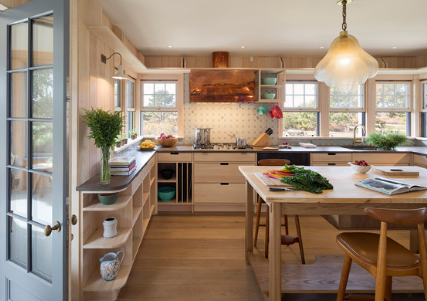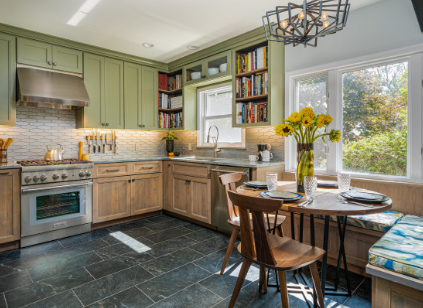A U-shaped kitchen, sometimes referred to as a C-shaped kitchen, has a workspace located on three adjacent cabinet walls and an open end for access. In a small U-shaped kitchen, the opposite cabinet actually becomes the kitchen layout, but closed at one end. This kitchen format is also suitable for larger kitchens, but this can reduce the efficiency of the kitchen if the relative running distance is too far. Is a U-shaped layout the right choice for your kitchen? If yes, how can you best utilize it?

Learn About the Pros and Cons of a U-Shaped Design
In general, U-shaped kitchens offer plenty of storage space and worktops. They are also very safe as they only have one entrance and no through trains. However, this last point also means that in a small U-shaped layout, it may only be possible to accommodate one chef at a time. It’s also worth noting that U-shaped layouts are typically more expensive than other layouts, such as kitchens or L-shaped designs, because they require more cabinetry and countertop materials to install additional cabinetry.

Plan Your Layout
The cabinet lengths of a U-shaped kitchen can be roughly the same or different; In both cases, there is an opportunity for flexibility in the design. If all walls are the same length (e.g., 10 feet), the starting point for planning usually depends on the location of the windows.
If one of the walls has a window, we usually recommend that you use it this way for your kitchen sink. Not only do windows provide natural light for washing dishes, but they also allow you to gaze out at romantic ideas while washing dishes. Of course, a lot depends on your perception.

Place the Sink and Stovetop
If the sink is in the middle of a U-shaped layout, then your hob can be located in any other area. However, if the two runways are of different lengths, longer walls will often accommodate the range to allow more space on either side of it.
At the same time, if the sink is located somewhere other than the middle sink (as shown), we will do our best to ensure that the countertop starts from this point and flows continuously around the United States. So, if you include tall cabinets, this will mean placing them at the farthest end of the cabinet (as in this kitchen). This well-designed spacing ensures that the counters are not disturbed and that the functionality of the kitchen (in the form of a kitchen layout) is not hindered.

Symmetry Is Employed
A U-shaped kitchen offers an opportunity for symmetry in the design, as long as it doesn’t compromise the usability of the kitchen. While this is not required, many homeowners appreciate symmetry for a clean and balanced aesthetic.
We usually choose a piece of equipment, such as an oven or an extra-large range hood, as the midpoint of the central operation, as shown in the image. Then we will work outward, equipping furniture and appliances accordingly.
Of course, you can deviate from the symmetrical layout, either because you think it will look better in your space, or because the structure of the room dictates – for example, if a doorway or window interrupts one of the passages.

Hide Not-so-Cute Features
U-shaped kitchens can also be designed to hide less appealing kitchen components and appliances behind cabinets. With far-sighted planning, they can be hidden. This is especially beneficial for open kitchens. In this kitchen, appliances are hidden in front of the cupboards.

Maximize Your Productive Workspace
Regardless of the size, a well-planned U-shaped kitchen design will ensure that only a limited number of steps are needed between the cabinets and appliances. This makes the kitchen much safer during the cooking process, especially when other people are present.
Plus, having plenty of counter space and storage means everything is within easy reach and easy to organize after use to maintain a clean and uncluttered appearance.

Merge Corner Storage
As mentioned earlier, one of the great things about a U-shaped kitchen is that having three rows of cabinets provides ample storage opportunities. That being said, the two corners of a typical U-shaped kitchen take up a lot of floor space.
Therefore, in order to achieve an ergonomic design, it is important to choose a professional kitchen corner solution, such as a carousel or a Le Mans corner unit (as shown in the picture, so called because of its shape and curves reminiscent of the famous French circuit). These make use of the original dead space in the corner cabinet. Without these options, you will lose this space, or the back of the cabinet will be difficult to access.

Add Peninsula Style
Small U-shaped kitchens can be restrictive, especially if there isn’t room for tables and chairs. But sometimes a U-shape can be arranged so that one of the legs extends into an open space (even if it means regrouping to remove the wall).
While you’ll lose the upper cabinets, the lower cabinets can form an efficient kitchen peninsula. You can add stools to make the space more social-friendly, and it will provide a useful platform for dining, working, or socializing. Alternatively, you can place a sink or stovetop in the area.
The peninsula is perfect for open plan spaces and provides physical isolation between the kitchen and living area, which is what many homeowners want.

Make Room for the Island
In general, if you want to include an island in this layout, you will need more space. As a rule of thumb, a U-shape with an island typically requires at least 3 feet of walkway on all sides between the cabinets and the island countertop. Since the cabinets around the island are more than 2 feet deep, and considering that the island is typically 3 to 4 feet deep, this means that the room needs to be at least 14 feet wide. We recommend a minimum room width of 14 feet for this layout to achieve optimal clearance around the island.

In contrast, for an open space, a depth of at least 8.5 feet is required. In this case, you’ll have a long back wall and two short wings, forming a U-shape and a kitchen island in the middle. As a rule, one of the shorter wings will accommodate tall houses, and the long back walls will accommodate a sink or stove, and there are alternatives on the island.
Depending on the location of the window, a shorter cabinet on the other side often provides additional countertop space for small appliances, such as toasters, blenders, and coffee makers.

Consider Curves
Some customers require the interior corners of the kitchen to have curves instead of square edges. The curved corners are effective for creating a sleek, fluid design that’s perfect for softening the look of your kitchen. The main disadvantage is the reduction of storage space. Most curved units don’t fully extend into the corners of the kitchen, reducing access and use of that space. This may not be a problem in larger U-shaped kitchens, but it’s worth noting when planning smaller spaces.

Customize Your Shape to Fit Your Space
One of the key things to remember about a U-shaped kitchen (aside from generous countertops and storage space) is that there is a lot of room for flexibility when designing.

From small spaces to large spaces, or U-shaped spaces with islands or peninsulas, you can achieve a variety of variations and possibilities with this layout. This means that you will most likely be able to design a U-shaped kitchen that fits you and fits your existing space.


